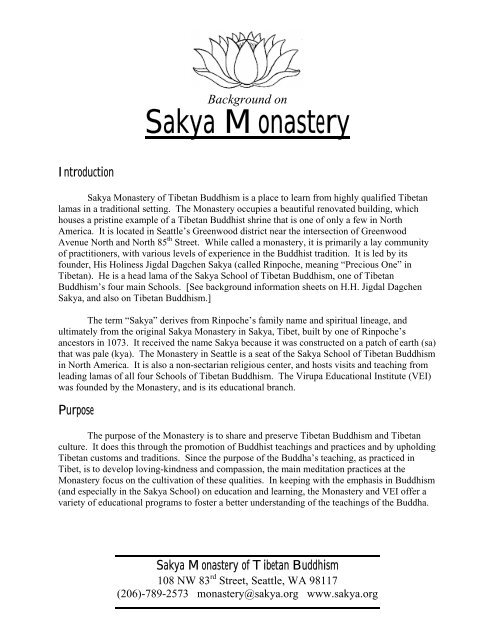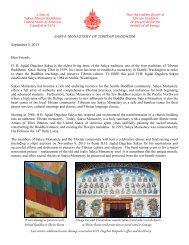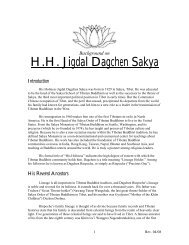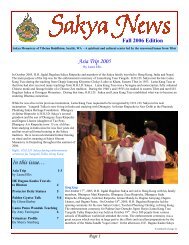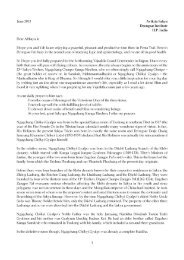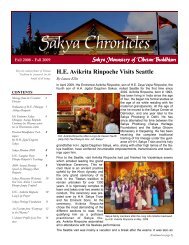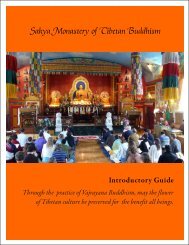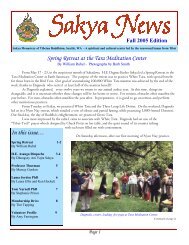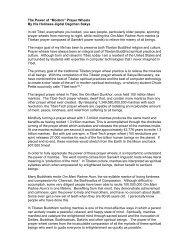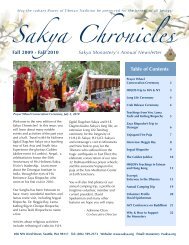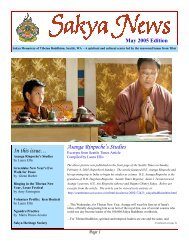Sakya Monastery.pdf - the Sakya Monastery of Tibetan Buddhism
Sakya Monastery.pdf - the Sakya Monastery of Tibetan Buddhism
Sakya Monastery.pdf - the Sakya Monastery of Tibetan Buddhism
You also want an ePaper? Increase the reach of your titles
YUMPU automatically turns print PDFs into web optimized ePapers that Google loves.
Background on<strong>Sakya</strong> <strong>Monastery</strong>Introduction<strong>Sakya</strong> <strong>Monastery</strong> <strong>of</strong> <strong>Tibetan</strong> <strong>Buddhism</strong> is a place to learn from highly qualified <strong>Tibetan</strong>lamas in a traditional setting. The <strong>Monastery</strong> occupies a beautiful renovated building, whichhouses a pristine example <strong>of</strong> a <strong>Tibetan</strong> Buddhist shrine that is one <strong>of</strong> only a few in NorthAmerica. It is located in Seattle’s Greenwood district near <strong>the</strong> intersection <strong>of</strong> GreenwoodAvenue North and North 85 th Street. While called a monastery, it is primarily a lay community<strong>of</strong> practitioners, with various levels <strong>of</strong> experience in <strong>the</strong> Buddhist tradition. It is led by itsfounder, His Holiness Jigdal Dagchen <strong>Sakya</strong> (called Rinpoche, meaning “Precious One” in<strong>Tibetan</strong>). He is a head lama <strong>of</strong> <strong>the</strong> <strong>Sakya</strong> School <strong>of</strong> <strong>Tibetan</strong> <strong>Buddhism</strong>, one <strong>of</strong> <strong>Tibetan</strong><strong>Buddhism</strong>’s four main Schools. [See background information sheets on H.H. Jigdal Dagchen<strong>Sakya</strong>, and also on <strong>Tibetan</strong> <strong>Buddhism</strong>.]The term “<strong>Sakya</strong>” derives from Rinpoche’s family name and spiritual lineage, andultimately from <strong>the</strong> original <strong>Sakya</strong> <strong>Monastery</strong> in <strong>Sakya</strong>, Tibet, built by one <strong>of</strong> Rinpoche’sancestors in 1073. It received <strong>the</strong> name <strong>Sakya</strong> because it was constructed on a patch <strong>of</strong> earth (sa)that was pale (kya). The <strong>Monastery</strong> in Seattle is a seat <strong>of</strong> <strong>the</strong> <strong>Sakya</strong> School <strong>of</strong> <strong>Tibetan</strong> <strong>Buddhism</strong>in North America. It is also a non-sectarian religious center, and hosts visits and teaching fromleading lamas <strong>of</strong> all four Schools <strong>of</strong> <strong>Tibetan</strong> <strong>Buddhism</strong>. The Virupa Educational Institute (VEI)was founded by <strong>the</strong> <strong>Monastery</strong>, and is its educational branch.PurposeThe purpose <strong>of</strong> <strong>the</strong> <strong>Monastery</strong> is to share and preserve <strong>Tibetan</strong> <strong>Buddhism</strong> and <strong>Tibetan</strong>culture. It does this through <strong>the</strong> promotion <strong>of</strong> Buddhist teachings and practices and by upholding<strong>Tibetan</strong> customs and traditions. Since <strong>the</strong> purpose <strong>of</strong> <strong>the</strong> Buddha’s teaching, as practiced inTibet, is to develop loving-kindness and compassion, <strong>the</strong> main meditation practices at <strong>the</strong><strong>Monastery</strong> focus on <strong>the</strong> cultivation <strong>of</strong> <strong>the</strong>se qualities. In keeping with <strong>the</strong> emphasis in <strong>Buddhism</strong>(and especially in <strong>the</strong> <strong>Sakya</strong> School) on education and learning, <strong>the</strong> <strong>Monastery</strong> and VEI <strong>of</strong>fer avariety <strong>of</strong> educational programs to foster a better understanding <strong>of</strong> <strong>the</strong> teachings <strong>of</strong> <strong>the</strong> Buddha.<strong>Sakya</strong> <strong>Monastery</strong> <strong>of</strong> <strong>Tibetan</strong> <strong>Buddhism</strong>108 NW 83 rd Street, Seattle, WA 98117(206)-789-2573 monastery@sakya.org www.sakya.org
The BuildingThe <strong>Monastery</strong>’s building was initially erected in 1928 as <strong>the</strong> First Presbyterian Church.Over <strong>the</strong> years, different Christian denominations have owned <strong>the</strong> building. In 1984, a Baptistgroup sold it to <strong>Sakya</strong> Tegchen Choling center (<strong>Sakya</strong> <strong>Monastery</strong>’s predecessor). Since it’sfounding in 1974, this center had successively outgrown accommodations in <strong>the</strong> Ravenna-Bryant, Capitol Hill, Wallingford, and University districts. When it moved to <strong>the</strong> Greenwoodarea, <strong>the</strong> center reorganized under H.H. Jigdal Dagchen <strong>Sakya</strong>, and adopted <strong>the</strong> name <strong>Sakya</strong><strong>Monastery</strong> <strong>of</strong> <strong>Tibetan</strong> <strong>Buddhism</strong>.Buying <strong>the</strong> large structure in Greenwood was a big step for <strong>the</strong> small center. Aremarkable event helped catalyze <strong>the</strong> purchase <strong>of</strong> <strong>the</strong> building. While <strong>the</strong> search was beingconducted for <strong>the</strong> center’s new home, Rinpoche had a dream in which he saw <strong>the</strong> destinedbuilding. Upon waking, he had architectural plans drawn for <strong>the</strong> building as revealed to him inhis vision. Amazingly, <strong>the</strong> Baptist Church was an exact match for <strong>the</strong>se vision-based plans and<strong>the</strong> decision was made to acquire <strong>the</strong> building.Since <strong>the</strong> purchase, many years <strong>of</strong> hard work and renovation by dedicated volunteershave brought <strong>the</strong> building to its present form and grace. At various stages <strong>of</strong> <strong>the</strong> renovation, <strong>the</strong>highest-ranking lamas in <strong>Tibetan</strong> <strong>Buddhism</strong>, including His Holiness <strong>the</strong> Dalai Lama, haveconsecrated <strong>the</strong> <strong>Monastery</strong>’s building and its contents, imbuing <strong>the</strong>m with <strong>the</strong> enlightened spirit<strong>of</strong> <strong>the</strong> Buddha and transforming <strong>the</strong> building into a North American home for <strong>the</strong> Buddha’steaching. In addition, <strong>the</strong> monastery contains many holy objects from India, Tibet, and Nepal.Following <strong>the</strong> first year <strong>of</strong> renovation, <strong>the</strong> downstairs cultural hall began to be used as aninterim location for <strong>the</strong> <strong>Monastery</strong>’s religious services. For <strong>the</strong> next twelve years <strong>the</strong> mainworship hall (<strong>the</strong> shrine room) underwent remodeling. Numerous Buddhist artworks weredonated by <strong>the</strong> <strong>Monastery</strong>’s members, friends, as well as by pr<strong>of</strong>essional artists and Rinpoche’sfamily. Extensive murals were painted on site. During this period, Bernardo Bertolucci shotscenes for <strong>the</strong> film Little Buddha at <strong>the</strong> <strong>Monastery</strong>. This venture helped pay for <strong>the</strong> new woodparquet floor in <strong>the</strong> shrine room. Outside <strong>the</strong> building, in keeping with <strong>the</strong> style <strong>of</strong> traditional<strong>Tibetan</strong> monasteries, a portico was added over <strong>the</strong> front entrance. By 1997, <strong>the</strong> remodeling wassufficiently finished so that <strong>the</strong> main shrine room could be used for meditations.In 1998, <strong>the</strong> outside <strong>of</strong> <strong>the</strong> <strong>Monastery</strong>’s building was painted in traditional <strong>Tibetan</strong> colorsand a memorial stupa was erected to Deshung Rinpoche (<strong>the</strong> lama who co-founded <strong>the</strong> original<strong>Sakya</strong> Tegchen Choling center). The bell shaped stupa is located in front <strong>of</strong> <strong>the</strong> <strong>Monastery</strong> andsymbolizes <strong>the</strong> Buddha’s enlightened mind. In 2001, a library addition capable <strong>of</strong> holding atleast 5,000 volumes was finished and opened.Two Levels <strong>of</strong> Religious TrainingIn <strong>Tibetan</strong> <strong>Buddhism</strong>, a religious community traditionally needs both a monastery and aretreat center. A <strong>Monastery</strong> maintains and preserves <strong>the</strong> teaching <strong>of</strong> <strong>the</strong> Buddha throughteaching, training, and practice. It houses monks who are trained in <strong>the</strong> intellectual, moral andritual teachings <strong>of</strong> <strong>the</strong> Buddha and is a focal point for religious activities <strong>of</strong> <strong>the</strong> lay community.2 Rev. 02/08
Nowadays, with <strong>the</strong> rapid changes taking place in Tibet, <strong>the</strong> monastery is also a place where<strong>Tibetan</strong>s endeavor to preserve <strong>the</strong>ir unique <strong>Tibetan</strong> identity and culture.The bustle <strong>of</strong> activity at a monastery means that it is not always conducive to developingpr<strong>of</strong>ound meditative experiences. For that, an isolated retreat center is necessary. In 2000, a<strong>Sakya</strong> <strong>Monastery</strong> student made a house and 72 acres <strong>of</strong> forest and ponds located on WhidbeyIsland available for use as a place for spiritual retreats. Thus, with teaching facilities in Seattleand a mediation center on Whidbey Island, <strong>Sakya</strong> <strong>Monastery</strong> provides a complete array <strong>of</strong>traditional methods <strong>of</strong> <strong>Tibetan</strong> religious training for <strong>the</strong> lay community as well as monks andnuns.Programs and Administration<strong>Sakya</strong> <strong>Monastery</strong> <strong>of</strong>fers a variety <strong>of</strong> activities for its members and friends. Foremost are<strong>the</strong> public meditations: Chenrezi meditations for developing loving-kindness and compassion areheld on Sunday morning at 10 am and Thursday evenings at 8 pm during daylight savings time(spring/summer) and 7:30pm during standard time (fall/winter). This is <strong>the</strong> main communalpractice <strong>of</strong> <strong>Sakya</strong> <strong>Monastery</strong>. Calm Abiding meditations, which are useful for <strong>the</strong> development<strong>of</strong> concentration and mental stability, are held on Friday nights at 7:00 pm.Numerous o<strong>the</strong>r ceremonies and meditations are held at <strong>the</strong> <strong>Monastery</strong>:• Buddhist holy days – such as <strong>the</strong> birth <strong>of</strong> <strong>the</strong> Buddha, and lama memorials.• Refuge ceremonies are regularly scheduled for people who wish to formally join <strong>the</strong>community <strong>of</strong> Buddhist practitioners and become a Buddhist.• Initiatory ceremonies, called “empowerments”, are bestowed by Rinpoche and o<strong>the</strong>rlamas upon request. These are required as a basis for special meditation practicesinvolving deities such as Chenrezi (<strong>the</strong> embodiment <strong>of</strong> compassion) or Green Tara (<strong>the</strong>grantor <strong>of</strong> protection).• Monthly meditations are also held that have specific requirements for practicing – such asbeing a Buddhist, or having received a specific empowerment or level <strong>of</strong> empowerment.Additionally, <strong>the</strong> <strong>Monastery</strong> <strong>of</strong>fers a variety <strong>of</strong> o<strong>the</strong>r programs and resources: TheChildren’s Dharma School for children ages 5 to 9 is available every Sundays. The <strong>Monastery</strong>library, available to members and visiting scholars, houses 2,500 books on <strong>Buddhism</strong>, Tibet, andcomparative religion, as well as audiotapes <strong>of</strong> teachings in <strong>Tibetan</strong> by noted lamas. The libraryhas a connection with <strong>the</strong> <strong>Tibetan</strong> Works & Archives in Dharamsala, Himachal Pradesh, India(home <strong>of</strong> <strong>the</strong> <strong>Tibetan</strong> Government-in-Exile). The Virupa Educational Institute administers andorganizes numerous classes, talks, book groups, discussions, and video showings held at <strong>the</strong><strong>Monastery</strong>. These programs are open to <strong>the</strong> public and are widely attended.Following <strong>Tibetan</strong> tradition, its Head Lama, H.H. Jigdal Dagchen <strong>Sakya</strong>, administrativelyleads <strong>the</strong> <strong>Monastery</strong>. He consults regularly with a fourteen-member Advisory Board. Ten <strong>of</strong> <strong>the</strong>Board’s members are elected by <strong>the</strong> members <strong>of</strong> <strong>the</strong> <strong>Monastery</strong>; <strong>the</strong> o<strong>the</strong>r four are <strong>the</strong> HeadLama, <strong>the</strong> <strong>Tibetan</strong> Cultural Advisor, <strong>the</strong> Executive Director, and an appointee drawn from <strong>the</strong><strong>Sakya</strong> family.3 Rev. 02/08


